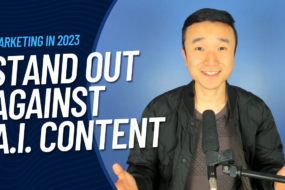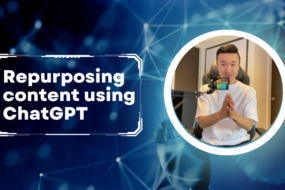
Here are the top five things that you need to know about LinkedIn and Edelman’s impact study on B2B thought leadership. I’ve read the report so you don’t have to. Let’s dive into it. First of all, what is this study? LinkedIn and Edelman work together and they’ve gathered 3,600 management level professionals.
These are people who consume the thought leadership contents. The goal of this study is to help marketers, communicators, and salespeople better understand when to use thought leadership and what attributes B2B audiences are looking for and what they wanna see from companies just like yours. Thought leadership material refers to content.
For example, thought pieces, essays, videos, webinars, live presentations, PowerPoint slides, research reports, you name it. Really, it’s your company’s way to deliver insights and expertise out there for your market. Key takeaway. A pandemic induced glu of low quality thought leadership content is diluting its perceived value among B2B decision makers.
This is so important to, to start off with, first and foremost, is that the pandemic has changed the landscape of thought leadership, and here’s what the study shows. The pandemic has resulted in a glutes of B2B thought leadership content. The shift to digital B2B content marketing was rapidly accelerated by the pandemic.
As you can imagine, a lot of marketing budgets were cut. Companies that used to host events are now shifting their budget to digital contents. Um, and this is diluting the landscape. 66% of decision makers say that the pandemic spawn a huge increase in the amount of thought leadership in the marketplace.
And approximately four in 10 final decision makers say that there is more thought. Then they can manage. So that is just something that we need to keep in mind when we’re thinking about thought leadership is there’s just so much of it out there. If you are gonna put something out there into the market, is it unique and is it valuable?
Those are gonna be increasingly important questions to consider. Still though consumption of B2B thought leadership remains really, really high. More than half of C-suite executives say they spend more time. Consuming thought leadership. Then before the pandemic began, people were working remote. They’re sitting in front of their computers.
The way they learn have shifted from conferences to more digital contents. 54% of decision makers and 48% of C-suites say they spend more than one hour per week reading and reviewing thought leadership. This is a part of people’s day-to-day roles now, so when we’re putting out thought leadership contents, know that there’s a demand and hunger.
The flood of low quality thought leadership has diluted its perceived value. And really this is the key takeaway at this first point here. 71% of decision makers say that less than half of the thought leadership they consume gives them valuable insights. And I’m sure we’ve all experienced this before.
You go read a piece of content and then you think, Well, did I really need to read that? Maybe they were stating the obvious quality is not what it used to be. And that’s the results of a lot of thought leadership flooding into the landscape. Can you take away. Thought leadership remains critical to B2B customer engagement, but breaking through the noise is harder than ever before.
So point number one, we talked about what the noise looks like, it’s that there’s more thought leadership than ever before. So how are we gonna cut through the noise? More and more? B2B purchasing does not include direct engagement with the provider. The role of thought leadership is really playing a very key role in the sales process, unlike before.
When you buy something, you’re always talking to an account executive. You’re talking to a customer success manager. Nowadays, buying decisions are often made before they even reach the provider. They’re reading thought leadership content, they’re reading your content, they’re consuming your videos well before they actually talk to you.
So a lot of times, by the time they talk to you, The decision has already been made, and it’s so important that we consider this rapidly changing dynamic of the sales funnel. B2B thought leadership when done well, significantly influences brand perception and buying behaviors throughout the entire decision making process, and really that’s a thing.
Thought leadership sets your sales process up for success. It puts your customers into a certain frame of mind or familiarity with your products. It builds authority and it builds a reputation well before they actually talk to you, so it sets you up for success every step along the way. Every touch point, if they’re already familiar with your brand, they trust your brand because of your thought leadership content.
Everything else just goes through so much more smooth. Decision makers consume thought leadership to stay educated on the trends affecting their industries and to generate new ideas for their business. So really it’s not as simple as going to watch a how-to video thought. Leadership content has become a fundamental way that key decisions make makers are driving business decisions.
They’re using it to inspire new ideas and change the way they work. And so there’s a very big role that thought leadership content plays, and that’s why it’s so. That they’re valuable. It does impact business decisions. 71% keep up to date with the latest thinking in my field or business sector. So keep in mind that it has to be relevant.
These things can often be very niche depending on what kind of business that they’re in. And generic thought leadership is just not gonna cut it. Attention spans are short. If you don’t pull buyers in quickly, they’re gone. And that’s been a growing trend over the. Quite a few years now as attention span, get shorter and shorter and shorter.
Everything is short form. It’s mobile. You don’t have as much time as you used to. Maybe it’s not the time to publish your a hundred page white paper. Think about how you can do short, engaging, catchy contents to cook people in. Before you lose ’em When it comes to quality, most B2B thought leadership lands in the middle.
As you can imagine with most things, lots of things are average. That’s why it’s called average. A lot of mediocre content out there. And then there are the two extremes. Ones that are really poor and ones that are really excellent. So keep that in mind. What you put in is what you get out. Garbage in, garbage out.
So, uh, when you’re thinking about thought leadership content, really be deliberate about it. Otherwise, you are putting yourselves on the wrong end of that. Key takeaway number three, Earning trust and credibility with decision makers requires strong thought leadership, especially if you’re not an established market leader.
And I think there’s something to be said that if you work for a Fortune 500 brand that everyone already knows, uh, it’s a lot easier to build that credibility cuz people already trust your brand. But if you’re not in that group, you’re not in that tier of brand awareness, you have to build that credibility.
The brand isn’t gonna do it. Gaining recognition as a challenger remains to be a challenge in and of itself. 60% of buyers say thought leadership builds credibility when entering a new category, when the brand is not already known. So if you don’t have that brand power, thought leadership is the beginning of that brand recognition for you.
47% of buyers say thought leadership led them to discover and ultimately purchase from a company that was not considered to be among the leaders in a particular category. And that’s what a challenger brand is, is if you are not the default solution to solving a certain problem or in the competitive landscape.
Really thought leadership is your best bet to be able to rise through and cut through the noise and compete with brands that have a stronger brand presence. Mitigating the impact of shrinking newsrooms and media blind spots is also another important thing to consider. Newsroom employment in the US decline 26% between 20, uh, 2008 and 2020.
Really, there’s this declining. Of newsrooms, and so what’s filling the space? And that’s social, that’s digital. That’s a lot of the content that we’re now consuming organically, peer to peer through platforms like LinkedIn. We’re not looking to newsrooms as much as we used to. 54% of buyers say that thought leadership is important for drawing attention to topics that news media rarely cover, but nonetheless are meaningful within their industries.
And so that’s another thing to consider too, is newsrooms have a certain preference or certain flavor they might be more likely to cover. Applicable content because that’s how their business model works. But thought leadership is your unique opportunity to talk about those specific topics that are extremely relevant to your customers and your business.
Recruitment is another thing that we should talk about too. 50% of buyers say thought leadership can be important in attracting the best talents. A lot of times when we’re talking about thought leadership, we immediately jump to marketing or brand awareness. But when we’re running a business, uh, we have to think multifaceted.
It’s not just about customers. It’s also about building that employer brand. Thought leadership can help establish your authority. Not just when customers are thinking to buy, but also when talent are deciding on whether or not they want to join your company. With over 40% of the global workforce considering leaving their employer this year, thought leadership can boost an organization’s ability to bring in talent.
Key takeaway number four, high performing thought leadership strikes a balance between being authoritative and provocative, yet human in tone and even fun. And this really is the great challenge is how do you make. Fun, insightful. You also want to challenge your audience perspective a little bit and great thought leadership content strikes a balance between all of these dynamics.
Great thought leadership, that’s both smart and enjoyable. 87% of buyers say that thought leadership content can be both intellectually rigorous and fun to consume At the same time, making sure that your content is not only insight. But also has a bit of personality to it, and I think an extreme would be something like a hundred page white paper where everything is facts and science and facts and science really to keep someone’s attention in this market of really rapidly decreasing attention span.
You need to make sure that you’re appearing human, approachable, interactive, and engaging. Never forget that otherwise, your content falls flat. , understand the specific needs of your customers. Almost half of buyers say that most thought leadership does not seem to be created with their specific needs in mind, and that is the trap that a lot of us falls into.
We’ve put out content that’s too generic, but really when people are looking for solutions that are problems, they’re very specific. So don’t shy away from creating very specific content to help. Very specific. Strike a more human personable tone. A more human, less formal tone of voice is much preferred, uh, predominantly features.
The point of view of an identifiable author is also another thing to consider too, is when we’re creating content, are we putting it out under a logo or a brand, which are often faceless, but when you put an author behind it through a video like this one, a human talking to you, that can go a long way to making content more.
Don’t be unoriginal or worse overly salesy. I think that is a very, very common trap. A lot of times when we’re thinking about marketing content, we wanna measure the end goal, which is some form of sales or conversion. But if we let that sales aspect influence the nature of the content itself, the content comes across too salesy.
People have their guards up, they have their barriers up, they look at your content and they feel like they’re being sold to and. They don’t trust anything anymore. So making sure that when you’re creating thought leadership content, really it is for the benefit of the audience. You’re out there to teach and to educate, and through that relationship builds to brands, which will influence purchasing decisions later on.
But if you let that slide and your content is too salesy, you’ll lose that trust. Right out the gates. Remember that one size does not fit all. Capture audience insights to understand which formats and styles perform the best. Really, this is about understanding your customers and your audience. Every type of customer belongs to a different demographic.
They consume content, they learn differently. So knowing your customers is really important. And of course, classic advice. Talk to your customers. Figure out how they learn. Are they on LinkedIn? Are they on Twitter? And making sure that you’re creating content that is unique to their. In the specific format and method that they prefer to learn short, quickly consumed content that makes a strong point, but maybe light on the details.
That’s something that’s, uh, really key this day and age with the decreasing attention span is just thinking about short form content and you can string together and maybe publish bits and pieces and nuggets of insights on a daily basis, um, to remain valuable. On an ongoing basis, instead of, you know, not speaking on the internet for, uh, a whole quarter and then publishing a long white paper, think about how you can through short form, engaging video content, stay in touch with your customers.
Key takeaway number five, With increase competition for attention and rapidly shifting buyer preferences. Now is a good time to reevaluate whether your thought leadership strategy is meeting your customer’s needs. So, you know, don’t. Go into a strategy started and then assume everything’s going fine.
It’s the same as all marketing strategies always be reevaluating, the landscape’s always changing. Your customer needs are always changing. Those things need to be taken into consideration. If your thought leadership is on autopilot, it’s time to take a closer look. A lot of our marketing strategies when we start the engine, we love.
The scalability of it, we just kick it into autopilot and then work on something else. Thought leadership is a little different than that. It’s not really something that you wanna be putting on autopilot. Think about it as a conversation between you and your customers. You don’t wanna autopilot your conversations.
You want to be talking to your customers day in, day out, making sure that you’re solving their problems in today’s digital first B2B environment. Thought leadership content is more important than ever before, but harder to do. Edelman and LinkedIn as part of this study, has designed a checklist of questions to help you assess whether your current approach to thought leadership is gonna be effective.
And here is a quick peek at it. So let’s wrap up this video with these nine things. Number one, beyond generating awareness, what business objectives will your thought leadership achieve? And that’s so important. What are you out there to. How are you gonna measure the success of it? Is it gonna be for conversion?
Is it gonna be brand awareness? You need to know what your objectives are to know whether or not you’re gonna hit them. And that’s gonna be the same for all marketing strategies. Of course. Who exactly is the target audience? And this is so important too, and thought leadership. As I mentioned before, it’s a conversation between you and the customer.
You need to know who you’re talking to in order to have an effective conversation. And the more specific you can be, the more relevant that content’s going. Number three. Are you focused on timely issues affecting your customers right now? That timeliness aspect is key to the modern day digital landscape.
When we’re on social media, when we’re Googling for contents, we’re often looking for things that are very relevant right now. Maybe there’s something happening on the landscape or in the, in the industry that week, making sure that you are part of that conversation, that timeliness, that speed to market, bringing that message right when people want to hear it, that’s gonna be key to.
Will your content teach customers something they don’t already know? So don’t go out there and, and just state the obvious. You know, you when, when people give you the time to consume your piece of content, they’re expecting some sort of value in return, and you want to be bringing something new and original to the conversation, whether it’s a perspective or just sharing something that the average person might not know.
Making sure that it’s not just the obvious is so important to building that trust that your content will always be valuable and keeping them coming back. Is the content overly salesy? Such a classic problem? We touched on it throughout this video, which is that when you’re creating contents, you have to keep in mind that you’re there to deliver value, value, value, value.
You’re helping them with problems. The conversion is just something, it’s a byproduct that may or may not happen. You don’t want to let that drive your content, otherwise you’ll lose trust Very. Number six. Who else can enhance the story you want to tell? Making sure that you’re involving your customers, community members, maybe sometimes even competitors.
Keep in mind that modern digital content is a conversation, and it doesn’t have to be a conversation between just your brand and your customers. There are other thought leaders in the space. There are other people that are doing all sorts of different things in the market that you operate in. So making sure that you’re involving others in the conversations, surfacing different perspectives and opinions.
That’s how you make for engaging contents who will be the face of the thought leadership. That’s another thing that’s important to consider too. Remember that when you publish content under a logo, it can often feel too corporate and flat. People come online to interact with people, not necessarily with logos.
And so if your thought leadership brand doesn’t have a face to it, That’s something to think about. Find out who within your team or within your company, you can elevate to be your thought leader. Put that face behind the thoughts and that will already make it much more personable. How will you stand out from the crowd?
Making sure that you have unique insights is one way to go, but also making sure that there’s a certain elements of intimacy in how you communicate that personability, but also that insight. Those are really important balances to think about, making sure that you spend a sufficient amount of time thinking about the thoughts behind the thought leader leadership.
What are those thoughts that you’re putting out there? Is it actually valuable? Is it unique? Those are all gonna help you cut through the noise. Last but not least, do you have the necessary measurement tools. This is gonna be one of the hardest nuts to crack. There’s just so much to marketing that’s difficult to track, especially these days when people are hopping from one channel to another, but making.
You tie this back to the original objectives. How are you gonna know whether or not this is accessful? Is it conversations generated? Is it number of times that your content is published and shared? Only you’re gonna know the right answer for your business, but never forget that you need tools in place in order to accurately measure the commitments that you’re putting out there into the market.
So that sums up the five key learnings. Um, again, this is the LinkedIn and Edelman study. It’s the impact study on B2B thought leadership. Hopefully you learn a thing or two, and next year when they publish another video, I’ll be sure to do another recap just like this one. Thank you for watching.






